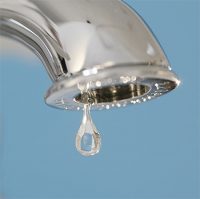Plumbing Tips
 Leaks are often the culprit for unexplained increased consumption, and toilet leaks are the most common. A toilet can waste thousands of gallons of water in a single billing period. Repairing a toilet leak is usually easy and relatively inexpensive to repair.
Leaks are often the culprit for unexplained increased consumption, and toilet leaks are the most common. A toilet can waste thousands of gallons of water in a single billing period. Repairing a toilet leak is usually easy and relatively inexpensive to repair.
To check for a leak, remove the top of the tank behind the bowl and put 3-4 drops of food coloring in the tank water. Don’t flush the toilet for an hour or more if possible. Check the water in the toilet bowl, and if the bowl water has been colored with the food coloring, then you have a leak. This type of leak is usually easy to repair by replacing the flapper assembly. if this does not work, consult a plumber.
Another leak that is common is a “leaky” faucet whether it is inside your home or at an outside faucet.
In order to determine if you have a water leak, read your water meter. Write the reading down and go back and re-read meter approximately 15-20 minutes later and see if any of the numbers on the meter have moved. There is also a leak indicator on most meters which is small triangle located on the face of the meters (some radio read meters have the symbol of a dripping faucet). If the leak indicator is moving and no water is being used, there is a leak somewhere. If there is a cut-off valve at the house, cut the water off at cut-off and go back to see if the meter is still moving. If so, the leak is in your water line. If not, the leak is probably somewhere in your house.
Click HERE for additional helpful tips for locating water leaks.
Installing a Water Pressure Reducing Valve
Because of Nolensville/College Grove Utility District’s geographical area, water main pressures can range from 20 PSI to 175 PSI. If the pressure is checked by a plumber and found to be above sixty pounds (60), N/CG recommends that pressure regulators be installed on the Customer’s side of the meter in order to protect service lines and appliances. Pressure regulators protect household appliances and increase water conservation.
Any water pressure in excess of 60 pounds at the meter should be regulated by the installation of a pressure regulator. Most customers need to install a pressure regulator in order to avoid excess pressure on the service line and plumbing connections. This is a voluntary installation and the cost is the customer’s and/or owner’s expense. These regulators may be purchased wherever plumbing supplies are sold. If you have any questions on this, your plumber can check your pressure before your service line is connected.
Conservation Tips
The average person uses 50 – 75 gallons of water every day. By becoming waste conscious, you can reduce your usage. Saving water saves money and also helps protect our most precious resource.
 These are some practical water conservation tips:
These are some practical water conservation tips:
- Wash only full loads in your washing machine and dishwasher.
- Do not run water continuously when washing dishes by hand.
- Attach low-flow faucet aerators to faucets.
- Take short showers instead of baths. A full bath requires approximately 36 gallons of water. A five-minute shower using a low-flow restrictor will use 15 – 25 gallons.
- Install low-flow shower heads and toilets. Low flow toilets typically use 1/2 the water of a standard toilet.
- Don’t leave the water running while brushing your teeth and/or shaving.
- Check for leaking faucets and toilets and repair them. A leaking tap, dripping once per second, wastes six gallons of water a day. A leaking toilet can waste up to 5,000 gallons per day.
- Use a nozzle on your hose that will stop the water flow when appropriate.
- Use a broom, not a hose, to clean driveways and sidewalks.
